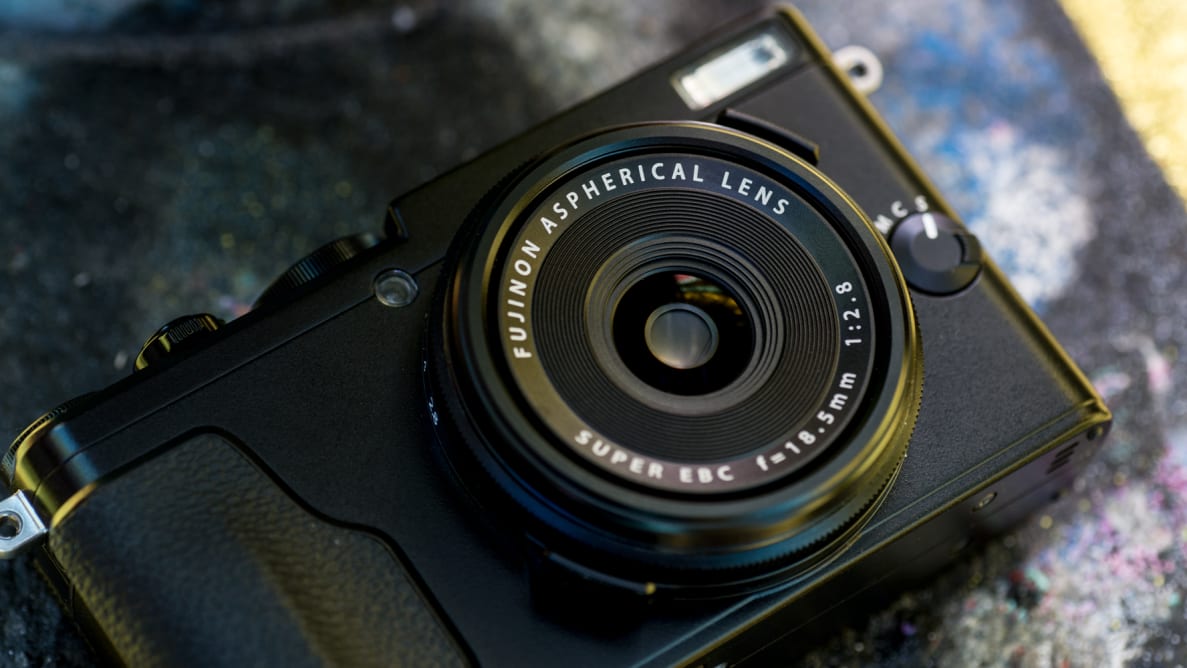Pros
Cons
That's where the new Fujifilm X70 ($699.95 MSRP) comes in. Following the GR model to a T, the X70 not only boasts great hardware, but comes at a great price and in a body that begs for attention. Easily the best mix of price and performance in Fuji's point-and-shoot lineup, the X70 carves an attractive niche for itself: good enough for a pro, accessible to an enthusiast, and affordable for all.
After spending over a week testing the X70 in our labs and out in the field, we're in agreement: this is our favorite point-and-shoot on the market right now. It's a bit of a drag for beginners craving more optical zoom, but if you're in the market for a great compact camera, the X70 should be your first stop.
Design & Handling
A good compromise leaves everyone mad
Fujifilm has made its name with retro-inspired camera like the X100, but the panoply of knobs and switches on a camera like that can be intimidating. Though it's definitely a treat for those who like exhaustive control, for most it's far too complicated. The X70 definitely hews closer to that kind of camera—and it's certainly going to appeal more to advanced photographers than novices—but it does a good job of keeping the layout sensible and clean.
{{ photo_gallery "tour" }}
Shooting with the X70 really takes me back to my one-hour photo days, and I suspect it'll be a fun bit of nostalgia for those who lament the death of film. Simply holding a metal body with solid manual controls harkens back to a time where everything was manual, and it's something I find comforting. The front control ring feels a lot like the aperture ring on the old Helios 44-2 50mm f/2 and the chunky, tactile controls scream "80's metal unibody shooter."
The X70—like the X100T before it—is built around a 16.3-megapixel APS-C sensor. For a point-and-shoot, this is quite massive; not only does that mean improved noise performance, but shots you take with the wide-angle 18.5mm f/2.8 fixed lens will have greater depth of field than what you could get with cameras that have smaller sensors like the Sony RX100 IV or Canon G3 X.

The auto switch toggles the creative shooting modes.
The lens is interesting, though again the lack of zoom will be a pain point for many beginners; most people upgrade from a smartphone because they want some zoom. But the lens is exceptional in low light and capable of capturing very fine detail even when wide open at f/2.8. If you do want to get a little closer, you can also use two simulated teleconverter settings buried in the menu to crop in a bit to 35 and 50mm equivalents, though it comes at a hit to image quality.
As we saw with the X-T1, X100T, and X-T10 before it, the X70 has a dedicated shutter speed dial, exposure compensation wheel, and shutter release at the top of the camera, with no mode dial to be found. This is the most confusing part of the camera, since the camera slips into different "modes" depending on how the aperture and shutter speed dials are set. So instead of a nice, big "Auto" mode you can just dial in, you have to set two separate dials up.
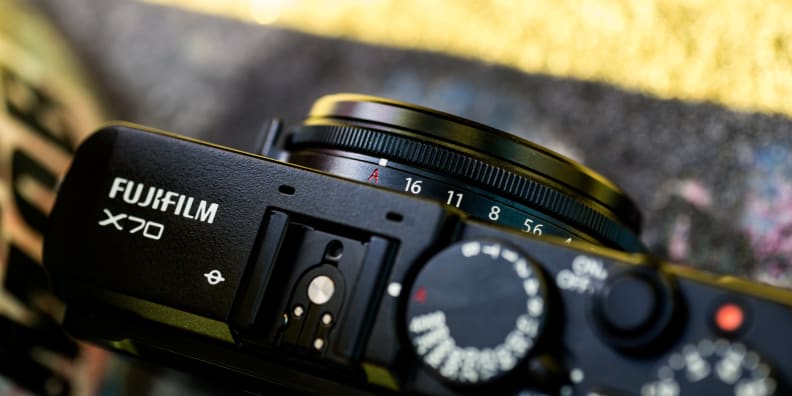
It's tough to see, but there are actually two dials on the lens: a manual aperture ring, and a control ring.
Enthusiasts may bemoan the lack of a viewfinder, but on the back of the X70 is a tilting 3-inch 1,040-k dot screen. Not only does this allow you take shots at off angles, but the touch controls also enable tap-to-autofocus—a great feature for a point-and-shoot. Outdoors, you may have issues with the screen being overpowered by the sun, but there is a separate optical viewfinder in the works that will give you some frame guidelines to work with.
In the Field
Shoot from the hip
Fans of older film cameras gravitate toward Fuji cameras because of their film simulation modes, and it's easy to see why. As the one-time giant of film production, Fuji knows that its Provia, Velvia, and Astia film types were once extremely popular—and the only way to get that look in your shots today is with a Fuji digital camera. The X70 in particular not only has a bevy of these film sim modes, but also filter effects as well—making your snaps far more interesting than the stock collection of Instagram filters.

Taking this camera out for a spin is a fun experience, but the ultra-wide 18.5mm fixed lens takes quite a bit of getting used to. This is a great focal length for landscapes, without zoom it'll "push" subjects further away. This is a great lens for close-ups, however, though the natural distortion can mess with the geometry of portraits.
If you do need to get closer there is the digital teleconverter, but it comes at a sacrifice to image quality. Instead of just cropping, the camera is cropping the image and then blowing it up to the original size—meaning your shots will be splotchy and ill-defined at full resolution. I'd just stick to taking full-sized shots then cropping down in post if you can. That way there's really not any quality loss.
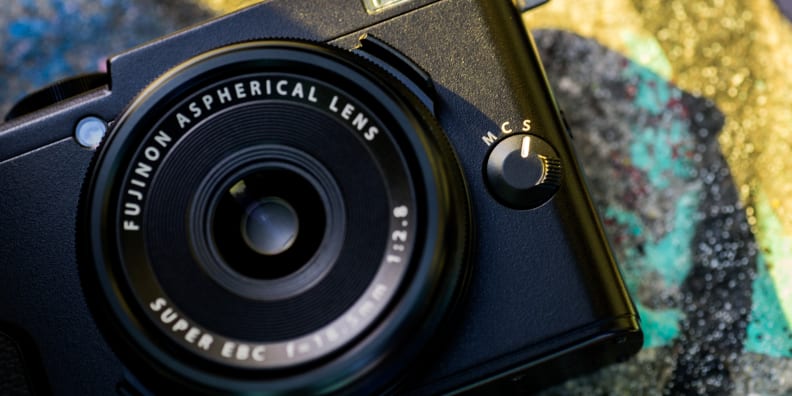
Quickly toggle your focus mode with this switch.
The X70's battery is surprisingly long-lasting, and it should last you for a full day. Barring cold temperatures sapping its life, the proprietary cell is rated for 330 shots. However, sometimes you're stuck without an outlet, so you might want to grab a secondary battery.
If you're a fan of post-processing your shots, the X70 comes with RAW shooting baked in. This filetype is a mainstay of professionals and nerds alike because it allows extremely granular control of how your shots look when using a program like Adobe Photoshop—but there's a catch. And that catch is the X70's X-Trans sensor layout.
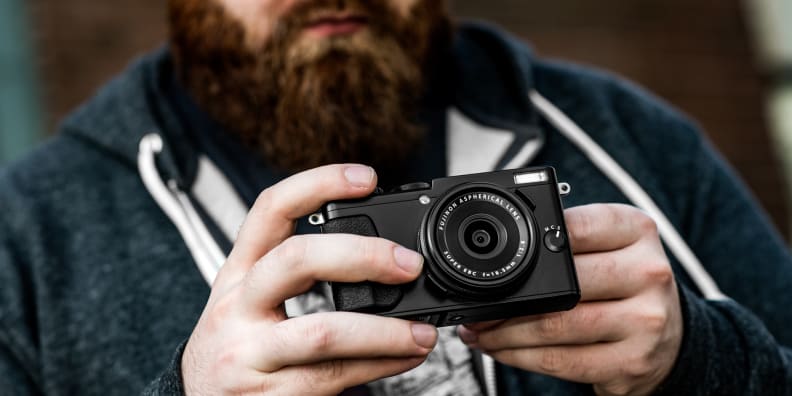
A lack of a viewfinder means using the tilting screen to frame your shots.
Traditional camera sensors (Bayer layout) use what's called anti-aliasing (AA) filters to reduce Moiré interference in shots with lots of fine detail, but it trades away some of its resolution to do so. Fuji instead uses a specialized kind of sensor (x-trans) that staggers its sub-pixels to increase sharpness without the need for an AA filter. However, that sometimes leads to issues where some post-processing software struggles to accurately piece together RAW files.
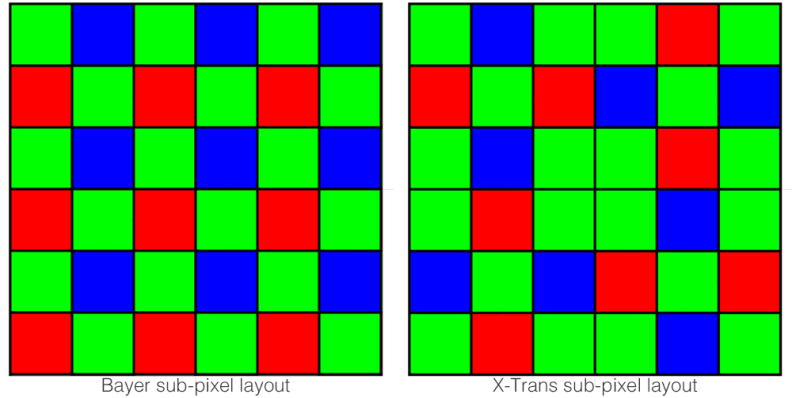
The X-Trans subpixel layout is considerably different than the traditional Bayer configuration. This allows the X70 to ditch the AA filter.
Performance
More muscle in your pocket
With its giant APS-C sensor comes giant expectations in the performance department. And in short, the X70 delivers—outside of the natural difficulties with the X-trans sensor, anyway.
If you're shooting in JPEG-only, you'll have seriously sharp shots, thanks in part to the lack of an anti-aliasing filter. In our labs, we recorded shots that easily rival those output by the beefier Fuji X-T10. The fixed wide-aperture lens and the 16-megapixel sensor are a stellar combo for a point and shoot, and while prime lenses are generally favored more by enthusiasts, the X70's glass is a great example why this is the case.
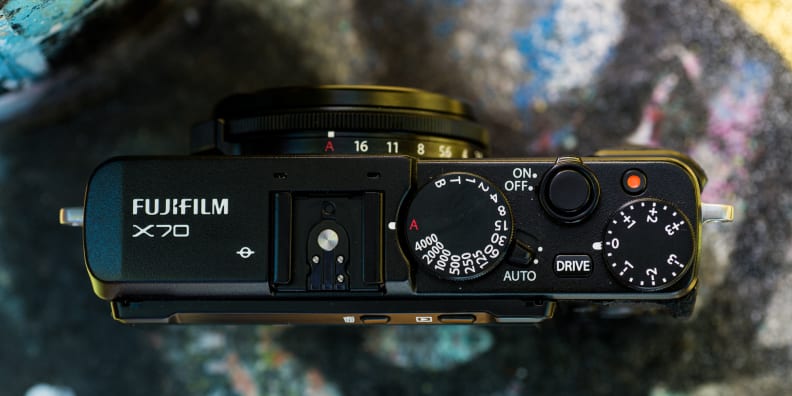
Those controls might look intimidating, but the automatic settings will bail out any confused photographer.
Leaving the film simulation mode on "standard" (Provia) will net you the most clinically accurate color performance, and the X70 doesn't get too cute with targeted oversaturation of blues, reds, and greens. You may notice that overall your photos have a bit more color saturation than is necessary, but you can either rein that in with post-processing or using the camera's settings to reduce overall saturation before you shoot.
Where that big sensor pays its biggest dividends is noise performance. Because the X70's APS-C sensor is far bigger than what you'd find on an average point and shoot, it can collect more light—and more easily produce an image with a lower sensitivity. Our testing confirms this, and it's really quite nice to know that whatever ISO—or noise reduction—setting you use, nets good results. Obviously, keeping your ISO speed lower will give you less unwanted noise, but that's seriously impressive.
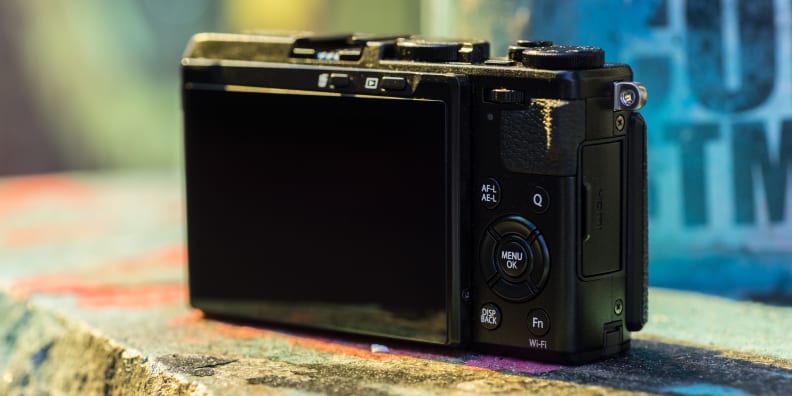
Controls are fairly simple, despite this camera's pedigree.
If there's one thing that really stinks on the Fuji X70 it's video. While it's not really a secret that Fuji doesn't exactly make video performance a priority on its enthusiast-geared cameras, it's consistently worse than other cameras in this category. Strange trailing, false-color artifacts, and generally lackluster sharpness dovetail to drag it all down, so videographers should look elsewhere.
{{ photo_gallery "sample-photo" }}
Conclusion
Fuji may have made one of the best compact point-and-shoots ever
While Fujifilm isn't the only camera company to put an APS-C sensor in a point-and-shoot sized body, it's arguably been the most successful. The X100T is a wonder, but it's still a relatively big, expensive camera. The X70 does a fantastic job of taking that blueprint and shrinking it down, while borrowing liberally from other successful variants such as the Ricoh GR.
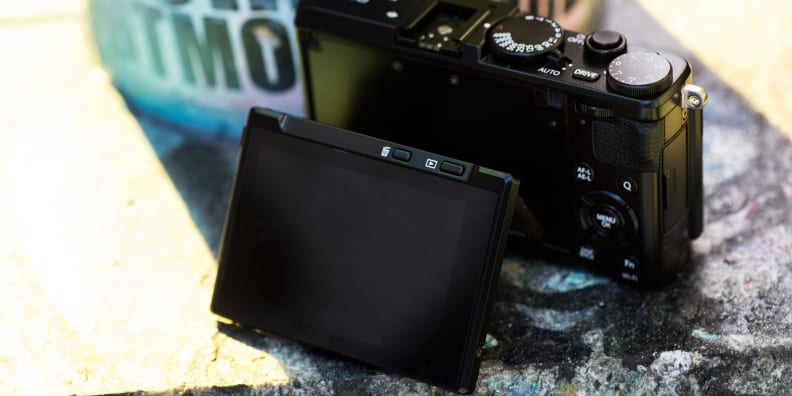
The tilting LCD is a great way to frame subjects at many angles.
The GR comparison is particularly exciting, because it's easily one of our favorite cameras of the past half-decade. Its small size, enthusiast-friendly control scheme, and stunning image quality all far outstripped its $700 price tag. The X70 is in many ways the same camera, hitting all the same notes—and the same price point—while offering improved performance.
{{amazon name="Fujifilm X100T Digital Camera (Silver)", asin="B00NF6ZGY6", align="right"}} And that price point is compelling enough that we'd even potentially recommend getting the X70 over other Fuji options like the X100T; it's more affordable (obviously) and other than the viewfinder there isn't a whole lot you're giving up. Other alternatives to look at would be the Panasonic LX100, which has a smaller Micro Four Thirds sensor and costs more money. You can find a Ricoh GR for less these days, but beyond that you're looking at getting a point and shoot with a smaller 1-inch sensor—and less distinct images—like Canon's G5 X or the Sony RX100 IV.
But every one of those cameras has some kind of drawback that makes it less compelling than the X70. Either they're bigger, or don't perform as well, or more expensive. While video shooters and those who need zoom should strongly consider something else, enthusiast photographers in need of a compact camera that can travel just about anywhere should not overlook this camera.
By the Numbers
In the lab, the X70 smoked our tests like you wouldn't believe. Super high sharpness, great color, decent white balance, and superb noise performance make this a great. However, Fuji seems to be content not to make video a priority, and the X70 falls short there.
Sharpness
With an overall average of 2296 line widths per picture height, the Fuji X70 is a seriously sharp shooter. Owing in large part to the sensor/lens combo, this camera boasts sharpness normally reserved for comparatively-specced mirrorless or DSLR cameras.
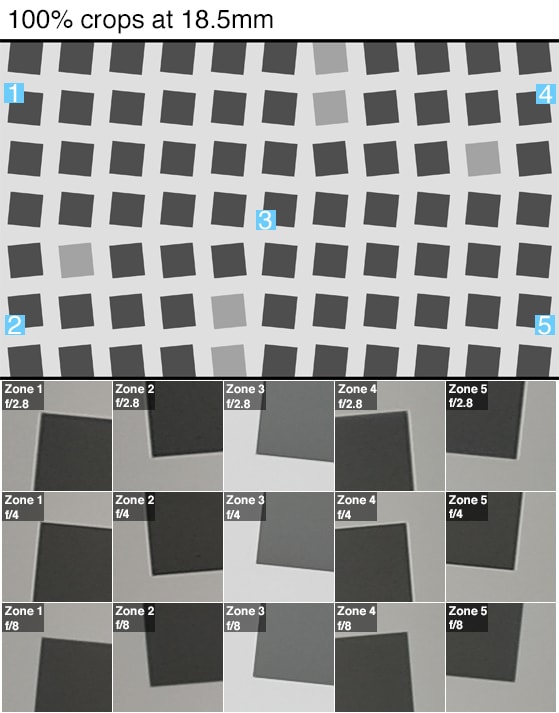
The X70 is strong on sharpness, but gets a software assist.
It does use a heavy hand with oversharpening by default, but you can turn this setting down/off if you so desire by digging through the Q menu. You may notice that hard edges get a little soft at the edges of the frame at f/2.8, but otherwise shots are sharp across the whole picture. For best results, I suggest sticking to f/4.
You may notice some haloing as a result of the oversharpening, but again, easily dealt with, and easy to miss.
Color & White Balance
Color is quite decent on the X70. With a ∆C 00 (saturation corrected) error of 2.24 and an overall saturation of 113.2%, you can't improve much without being perceptually perfect, so kudos Fuji!
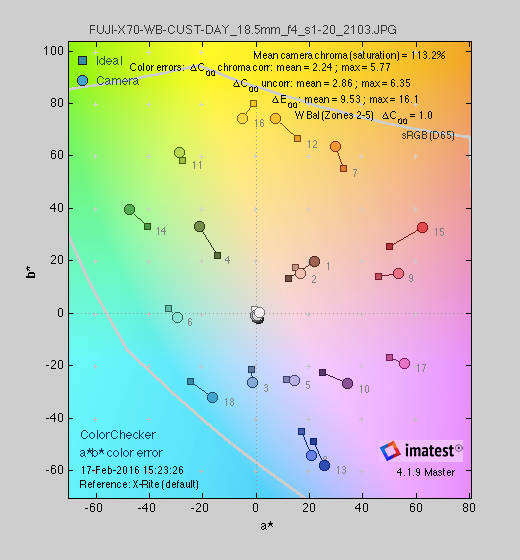
White balance is another issue, however. Like most cameras, it struggles in incandescent light—posting color temperature error of around 2000 kelvin. However, it does famously well in daylight or fluorescent light. In both conditions, you can expect less than 400 kelvin errors. Not bad if I do say so myself.
Noise
Noise just isn't an issue on the X70. At all. You may want to turn down noise reduction to -2 in the Q menu, but even without aggressive NR, the X70's highest level of grain only ends up being 1.81% at ISO 6400. That's commendable, especially for a point and shoot. Not much to talk about here.
Meet the tester
A seasoned writer and professional photographer, Chris reviews cameras, headphones, smartphones, laptops, and lenses. Educated in Political Science and Linguistics, Chris can often be found building a robot army, snowboarding, or getting ink.
Checking our work.
Our team is here to help you buy the best stuff and love what you own. Our writers, editors, and experts obsess over the products we cover to make sure you're confident and satisfied. Have a different opinion about something we recommend? Email us and we'll compare notes.
Shoot us an email
